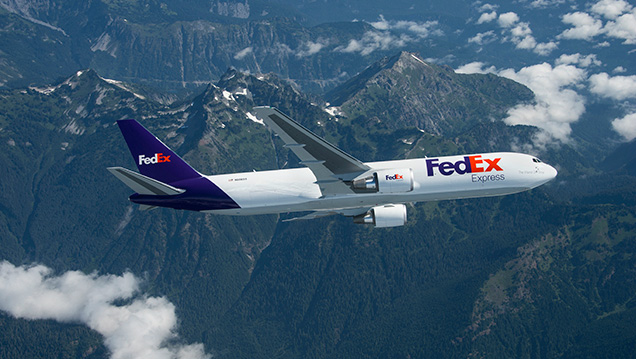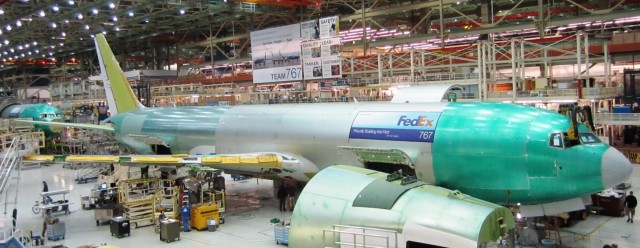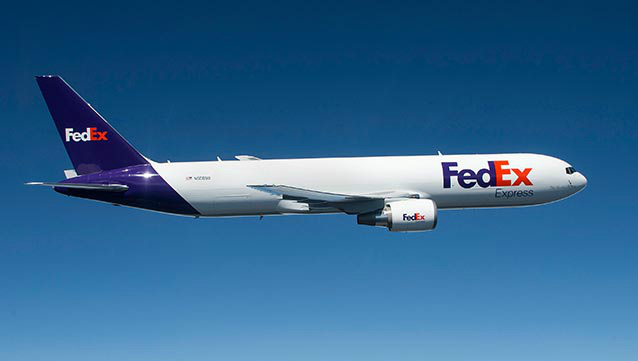FedEx Express (redundant, right?) is the air freight branch of the shipping and delivery giant, operating a massive fleet of airliners. These include DC-10s (also referred to as MD-10s), MD-11s, 777Fs, and now, their brand-new Boeing 767-300F. At a fleet count of over 300 ’œmainline’ aircraft (those narrow and wide-bodies not operated by feeders), how big is FedEx as an airline? Bigger than British Airways, Lufthansa, Emirates, ANA, Qantas, or US Airways. With a 50-plane backlog on the 767-300F, FedEx is taking drastic steps to modernize their fleet in the name of fuel efficiency and reliability.
The years of experience Boeing has in building and refining the 767 line has resulted in an airframe that satisfies the cargo mission very effectively. The 767-300F is based upon the 767-300ER passenger variant, with its upsized range, MTOW, and fuel capacity. FedEx expects a 30% fuel burn reduction compared to the DC/MD-10 models the 767-300F is replacing.
Also beneficial is the fact that, just as with the commercial variants, the 757 and 767 freighter models in FedEx’s fleet share commonalities that allow for the sharing of pilots, parts, and training. “We are excited to see the 767 Freighter join the FedEx fleet,” said Brad McMullen, vice president of North America Sales, Boeing Commercial Airplanes. “The 767 Freighter, with its tremendous efficiency among medium wide-body cargo airplanes, will complement FedEx’s fleet and support fast, reliable deliveries to customers around the world.”
We expect that the 767-300F aircraft will be used mostly on medium-haul flights, such as Memphis to Las Vegas and Atlanta, given its status as a DC-10 replacement. That being said, according to Jim McCluskey with FedEx Communications, they ’œhave not verified routing information at this time.’
The September 4th arrival of the first 767F is the first of a firm 50-plane order to be delivered through 2019, but FedEx also has options for 35 additional planes. 2019 deliveries for brand-new 767s seems pretty amazing, especially when you consider that the first 767 was first delivered in 1981.
On top of the 767, FedEx also has outstanding orders for 777 freighters as well.
As we look at the long-lived 767’²s new role for FedEx, don’t forget that the KC-46A fuel tanker for the Air Force is in the development stages too (based on the -200ER). The first flight is expected in 2014, 33 years after the first 767 flight. Deliveries of this variant are expected for nearly two more decades!
BONUS: Video of the KC-46A program shown at Farnborough 2012
FedEx’s 767 program is good news for everyone. FedEx gets a new, more fuel-efficient freighter to help fulfill their operational needs at a much lower operating cost. Boeing gets to continue to build new 767 airframes, which along with other orders will keep the line rolling for years to come. As the third winner, AvGeeks will see 767s in the sky for decades to follow.



Nice Story. I would like to add that the DC-10 and the MD-10,while sharing common type certificate, are very different aircraft in the flight deck. The MD-10 flight deck is nearly identical to the MD-11. Some DC-10’s from American and United received their cargo door mod and flight deck upgrade while I was working for MDRAMS in Phoenix. It was a great project and the DC-10 is a very robust airframe that will be missed. The DC-10/MD-10/MD-11 are among the last of the American “three holers”. While they have not seen scheduled passenger service in the United States in some years, they still served safely and reliably in charter and cargo operations. With the homage to the DC-10 out of the way, the 767 is a capable and efficient aircraft in its own right. The only problem I ever had with it was that industry standard LD-3 lower deck containers used on most wide body aircraft, could not be loaded side by side, requiring a new “specialized” container.
Why didn’t they get winglets?